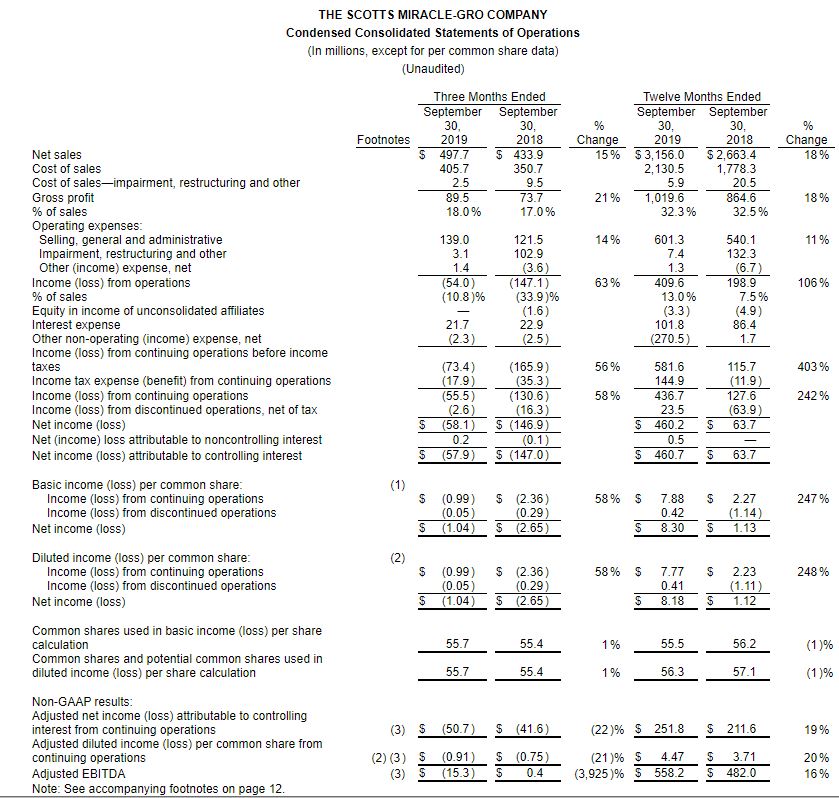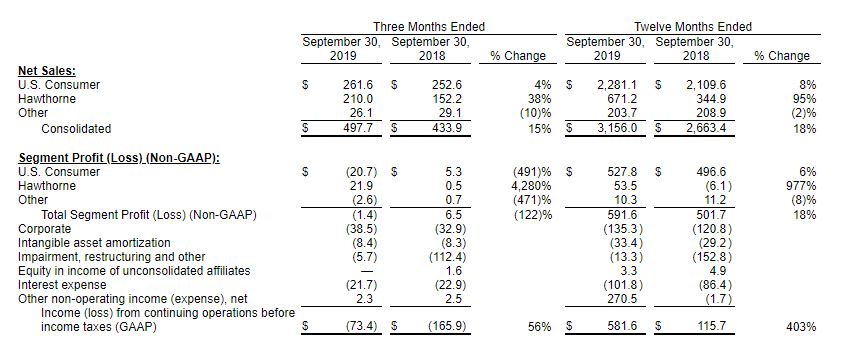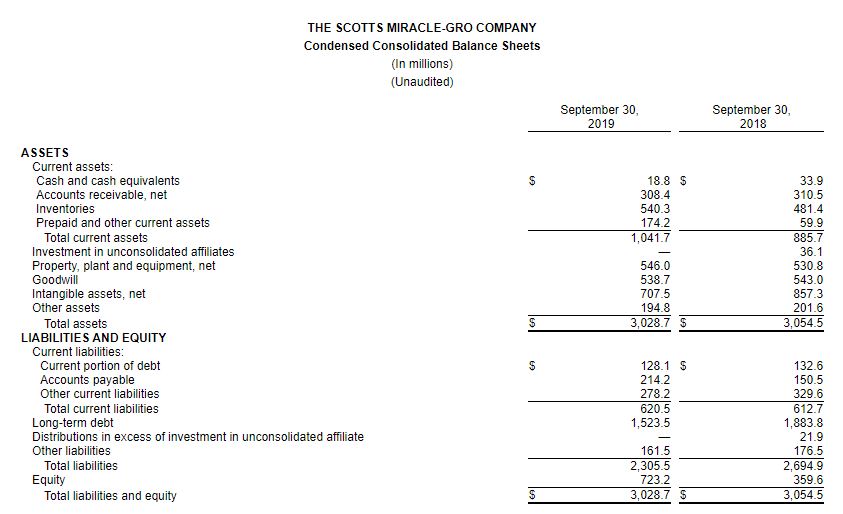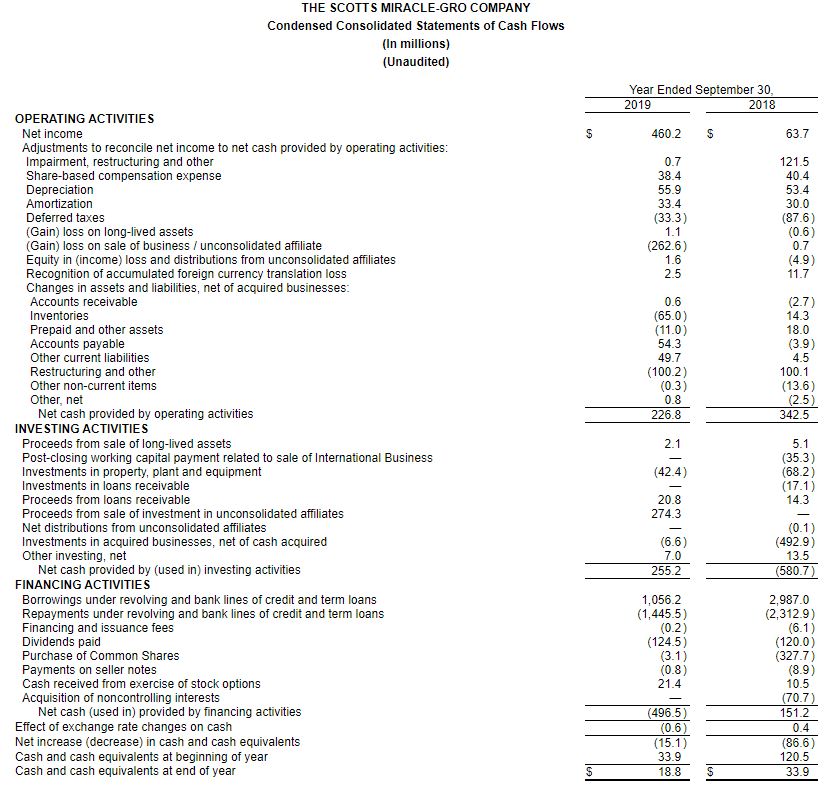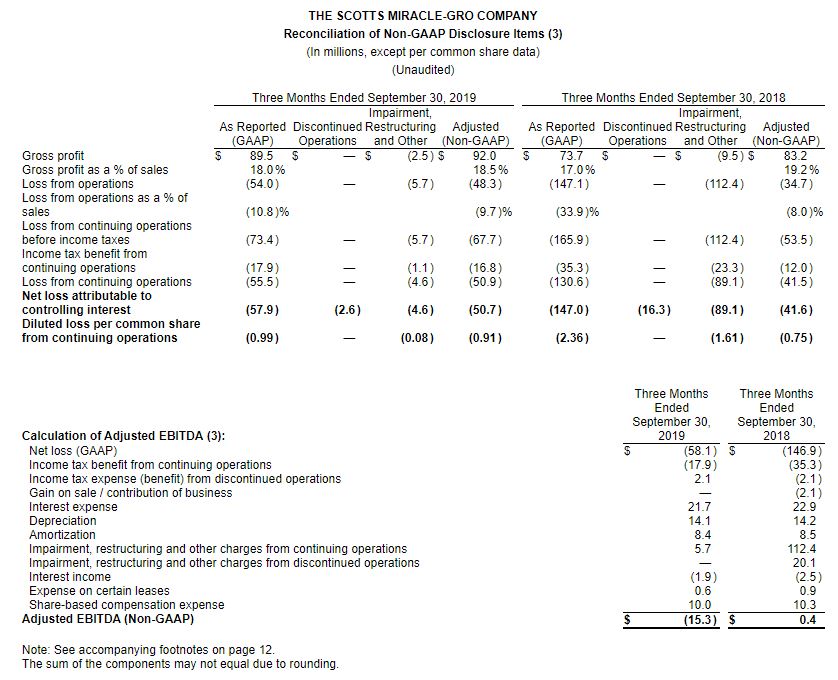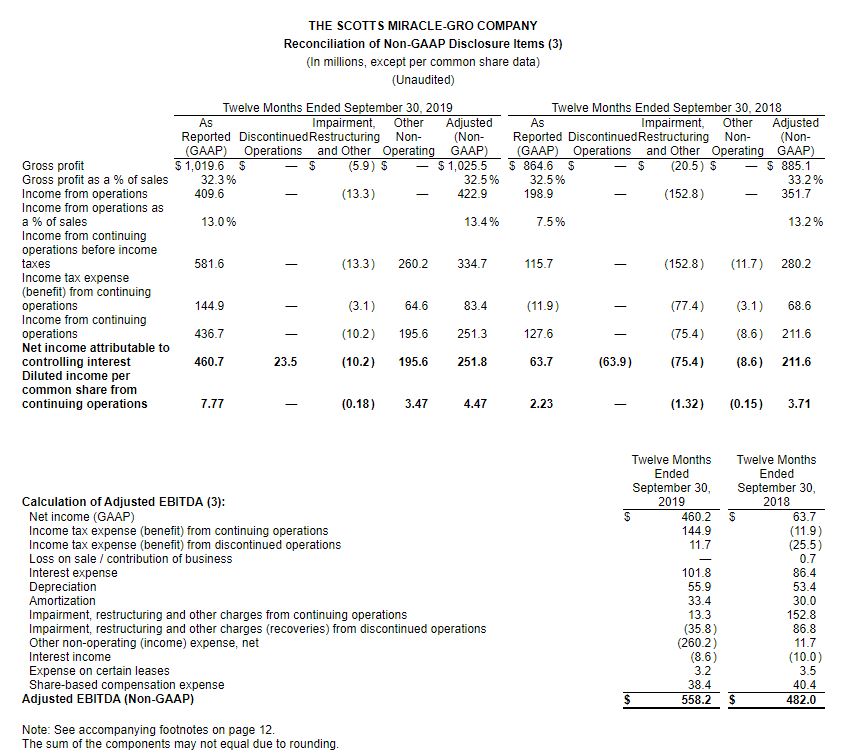
ScottsMiracle-Gro Announces Strong Fourth Quarter Results; U.S. Consumer and Hawthorne Segments Exceed Expectations
- U.S. Consumer segment sales increase 8% for full year, up 4% in Q4
- Hawthorne sales increase 38% in Q4 driven by strong demand across U.S.
- Full-year GAAP earnings of $7.77 per share; Q4 net loss of $0.99 per share
- Non-GAAP adjusted full-year EPS of $4.47; Q4 adjusted loss of $0.91 per share
- Company sets fiscal 2020 adjusted non-GAAP guidance of $4.95 to $5.15 per share on expected sales growth of 4 to 6%
MARYSVILLE, Ohio, Nov. 06, 2019 (GLOBE NEWSWIRE) — The Scotts Miracle-Gro Company (NYSE: SMG), the world’s leading marketer of branded consumer lawn and garden as well as indoor and hydroponic growing products, today released record fiscal fourth quarter and full year financial results that were driven by the continued strength of both its U.S. Consumer and Hawthorne reporting segments.
The Company also established guidance for fiscal 2020 that assumes company-wide sales growth of 4 to 6 percent, based on the continued strength of its two primary business segments, resulting in expected non-GAAP adjusted earnings growth in a range 11 to 15 percent.
For the year ended September 30, 2019, company-wide sales increased 18 percent to a record $3.16 billion, compared with $2.66 billion a year earlier. GAAP earnings from continuing operations were $7.77 per diluted share, compared with $2.23 per share in the prior year. Non-GAAP adjusted earnings, which is the basis of the Company’s guidance and excludes impairment, restructuring, and other one-time items, were $4.47 per share compared with $3.71 per share a year ago.
“Fiscal 2019 showed the strength of our business when we execute on all cylinders,” said Jim Hagedorn, chairman and chief executive officer. “New products accounted for 15 percent of our sales in our U.S. Consumer business, we saw growth in every major retail channel, and we drove increased consumer participation in nearly every category in our industry. In Hawthorne, we further established our clear leadership with indoor growers, improving our market share and growing our full-year sales 24 percent on an apples-to-apples basis.
“In all areas of the company our associates exceeded expectations and put us in a solid position to continue delivering strong results that enhance shareholder value in fiscal 2020.”
Fourth quarter details
Company-wide sales increased 15 percent to $497.7 million. U.S. Consumer increased 4 percent to $261.6 million from $252.6 million. Hawthorne sales increased 38 percent to $210.0 million compared with $152.2 million. The increase at Hawthorne was across nearly all product categories with strong growth in both legacy and emerging markets.
The momentum in Hawthorne has been building all year and we saw our highest levels of organic growth in the fourth quarter, giving us a high degree of confidence as we look ahead into fiscal 2020.
 Jim Hagedorn, chairman and chief executive officer
Jim Hagedorn, chairman and chief executive officer
During the quarter, we reported strong growth – often above 50 percent – in established West Coast markets, especially California, as well as emerging markets like Michigan, Florida and Massachusetts. We also saw consistent growth in lighting, nutrients and other major product categories.
For the quarter, the GAAP and non-GAAP adjusted gross margin rate was 18.0 percent and 18.5 percent, respectively, compared with 17.0 percent and 19.2 percent, respectively, in the prior year. The decline in the non-GAAP adjusted rate is due primarily to higher distribution costs. SG&A increased 14 percent to $139.0 million primarily due to higher accruals for annual incentive compensation payments.
Interest expense decreased $1.2 million on a year-over-year basis to $21.7 million. The Company said its leverage ratio at the end of the quarter was approximately 3.7 times average debt-to-EBITDA.
The Company reported a seasonal loss from continuing operations of $55.5 million, or $0.99 per diluted share, compared with a loss of $130.6 million, or $2.36 per diluted share. The non-GAAP adjusted loss in the quarter, which excluded impairment, restructuring, as well as other one-time items, was $50.7 million, or $0.91 per diluted share, compared with a loss of $41.6 million, or $0.75 per diluted share.
Fiscal 2019 Details
Company-wide sales on a full year basis increased 18 percent to $3.16 billion compared with $2.66 billion a year ago. Sales in the U.S. Consumer segment increased 8 percent, to $2.28 billion due to increased retail support and inventory levels and strong consumer demand. Hawthorne sales increased 95 percent to $671.2 million due to strong demand and the full-year impact of the acquisition of Sunlight Supply.
The GAAP gross margin rate on a year-to-date basis was 32.3 percent. The non-GAAP adjusted rate was 32.5 percent. These compare with 32.5 and 33.2 percent, respectively, last year. The non-GAAP decline was primarily driven by the impact of the Sunlight Supply acquisition and Hawthorne’s increased promotional activity, which has helped drive higher volume and improved market share, partially offset by higher pricing.
SG&A was $601.3 million, an 11 percent increase from 2018, due to higher accruals for annual incentive compensation payments, increased media investments and the impact from the June 2018 acquisition of Sunlight Supply.
Increased borrowing resulted in an increase in interest expense to $101.8 million compared with $86.4 million.
GAAP income from continuing operations was $436.7 million, or $7.77 per diluted share, compared to $127.6 million, or $2.23 per share in prior year. Non-GAAP adjusted earnings, which excluded impairment, restructuring, as well as the other one-time items, were $251.8 million, or $4.47 per share, compared with $211.6 million, or $3.71 per share a year ago.
Operating cash flow for the full year was $226.8 million, compared with $342.5 million. Those results include $145 million in one-time payments associated with previously disclosed litigation settlements, as well as the tax implications associated with divesting the Company’s 30 percent stake in TruGreen. Setting aside those one-time payments, free cash flow, which the Company defines as operating cash flow minus capital expenditures, was $329 million.
“Across the board, I am extremely pleased with our results for the year and believe ScottsMiracle-Gro is well positioned as we enter fiscal 2020,” said Randy Coleman, executive vice president and chief financial officer. “I am particularly encouraged by our continued focus on cash flow, which we see as our most important financial metric.”
Fiscal 2020 outlook
The Company established guidance for fiscal 2020 based on an expectation of continued growth in both major segments. Management said it expects sales growth on a company-wide basis of 4 to 6 percent. It expects Hawthorne sales to grow approximately 12 to 15 percent and U.S. Consumer sales to improve 1 to 3 percent.
“While the expected growth rates in the U.S. Consumer business and Hawthorne are slightly lower in 2020, the basic fundamentals remain the same,” Coleman said. “We anticipate total company growth largely from volume as well as modest price increases that are necessary to offset expected pressure from certain commodities and tariffs.”
Non-GAAP adjusted earnings per share are anticipated to be in a range of $4.95 to $5.15, and free cash flow is expected to be approximately $300 million. Management will outline its 2020 expectations in more detail during its scheduled conference call with the investment community at 9 a.m. Eastern time today.
Conference Call and Webcast Scheduled for 9 a.m. ET Today, November 6
The Company will discuss results during a webcast and conference call today at 9:00 a.m. Eastern Time. Conference call participants should call 866-337-5532 (Conference Code: 1062443) A live webcast of the call will be available on the investor relations section of the Company’s website at http://investor.scotts.com. An archive of the webcast, as well as any accompanying financial information regarding any non-GAAP financial measures discussed by the Company during the call, will remain available for at least 12 months. In addition, a replay of the call can be heard by calling 888-203-1112. The replay will be available for 30 days.
About ScottsMiracle-Gro
With approximately $3.2 billion in sales, the Company is one of the world’s largest marketers of branded consumer products for lawn and garden care. The Company’s brands are among the most recognized in the industry. The Company’s Scotts®, Miracle-Gro® and Ortho® brands are market-leading in their categories. The Company’s wholly-owned subsidiary, The Hawthorne Gardening Company, is a leading provider of nutrients, lighting and other materials used in the indoor and hydroponic growing segment. For additional information, visit us at www.scottsmiraclegro.com.
THE SCOTTS MIRACLE-GRO COMPANY
Segment Results
(In millions)
(Unaudited)
The Company divides its business into three reportable segments: U.S. Consumer, Hawthorne and Other. U.S. Consumer consists of the Company’s consumer lawn and garden business located in the geographic United States. Hawthorne consists of the Company’s indoor, urban and hydroponic gardening business. Other consists of the Company’s consumer lawn and garden business in geographies other than the U.S. and the Company’s product sales to commercial nurseries, greenhouses and other professional customers. Corporate consists of general and administrative expenses and certain other income/expense items not allocated to the business segments. This identification of reportable segments is consistent with how the segments report to and are managed by the chief operating decision maker of the Company.
The performance of each reportable segment is evaluated based on several factors, including income (loss) from continuing operations before income taxes, amortization, impairment, restructuring and other charges (“Segment Profit (Loss)”), which is a non-GAAP financial measure. Senior management uses Segment Profit (Loss) to evaluate segment performance because they believe this measure is indicative of performance trends and the overall earnings potential of each segment.
The following tables present financial information for the Company’s reportable segments for the periods indicated:
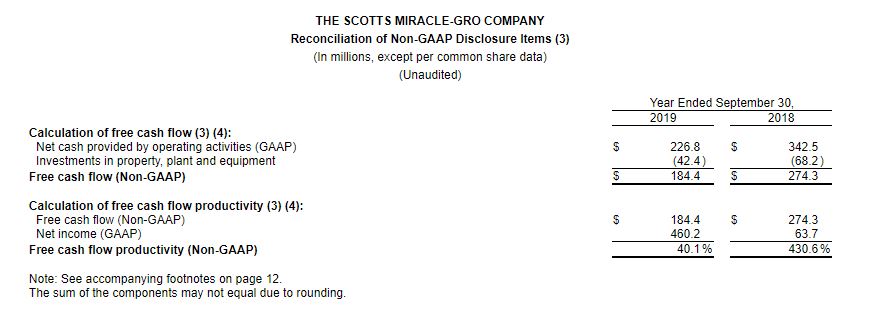
THE SCOTTS MIRACLE-GRO COMPANY
Footnotes to Preceding Financial Statements
(1) Basic income (loss) per common share amounts are calculated by dividing income (loss) attributable to controlling interest from continuing operations, income (loss) from discontinued operations and net income (loss) attributable to controlling interest by the weighted average number of common shares outstanding during the period.
(2) Diluted income (loss) per common share amounts are calculated by dividing income (loss) attributable to controlling interest from continuing operations, income (loss) from discontinued operations and net income (loss) attributable to controlling interest by the weighted average number of common shares, plus all potential dilutive securities (common stock options, performance shares, performance units, restricted stock and restricted stock units) outstanding during the period.
(3) Reconciliation of Non-GAAP Measures
Use of Non-GAAP Measures
To supplement the financial measures prepared in accordance with U.S. generally accepted accounting principles (“GAAP”), the Company uses non-GAAP financial measures. The reconciliations of these non-GAAP financial measures to the most directly comparable financial measures calculated and presented in accordance with GAAP are shown in the tables above. These non-GAAP financial measures should not be considered in isolation from, or as a substitute for or superior to, financial measures reported in accordance with GAAP. Moreover, these non-GAAP financial measures have limitations in that they do not reflect all the items associated with the operations of the business as determined in accordance with GAAP. Other companies may calculate similarly titled non-GAAP financial measures differently than the Company, limiting the usefulness of those measures for comparative purposes.
In addition to GAAP measures, management uses these non-GAAP financial measures to evaluate the Company’s performance, engage in financial and operational planning and determine incentive compensation because it believes that these measures provide additional perspective on and, in some circumstances are more closely correlated to, the performance of the Company’s underlying, ongoing business.
Management believes that these non-GAAP financial measures are useful to investors in their assessment of operating performance and the valuation of the Company. In addition, these non-GAAP financial measures address questions routinely received from analysts and investors and, in order to ensure that all investors have access to the same data, management has determined that it is appropriate to make this data available to all investors. Non-GAAP financial measures exclude the impact of certain items (as further described below) and provide supplemental information regarding operating performance. By disclosing these non-GAAP financial measures, management intends to provide investors with a supplemental comparison of operating results and trends for the periods presented. Management believes these measures are also useful to investors as such measures allow investors to evaluate performance using the same metrics that management uses to evaluate past performance and prospects for future performance. Management views free cash flow as an important measure because it is one factor used in determining the amount of cash available for dividends and discretionary investment. Management views free cash flow productivity as a useful measure to help investors understand the Company’s ability to generate cash.
Exclusions from Non-GAAP Financial Measures
Non-GAAP financial measures reflect adjustments based on the following items:
- Impairments, which are excluded because they do not occur in or reflect the ordinary course of the Company’s ongoing business operations and their exclusion results in a metric that provides supplemental information about the sustainability of operating performance.
- Restructuring and employee severance costs, which include charges for discrete projects or transactions that fundamentally change the Company’s operations and are excluded because they are not part of the ongoing operations of its underlying business, which includes normal levels of reinvestment in the business.
- Costs related to refinancing, which are excluded because they do not typically occur in the normal course of business and may obscure analysis of trends and financial performance. Additionally, the amount and frequency of these types of charges is not consistent and is significantly impacted by the timing and size of debt financing transactions.
- Discontinued operations and other unusual items, which include costs or gains related to discrete projects or transactions and are excluded because they are not comparable from one period to the next and are not part of the ongoing operations of the Company’s underlying business.
The tax effect for each of the items listed above is determined using the tax rate and other tax attributes applicable to the item and the jurisdiction(s) in which the item is recorded.
Definitions of Non-GAAP Financial Measures
The reconciliations of non-GAAP disclosure items include the following financial measures that are not calculated in accordance with GAAP and are utilized by management in evaluating the performance of the business, engaging in financial and operational planning, the determination of incentive compensation, and by investors and analysts in evaluating performance of the business:
Adjusted gross profit: Gross profit excluding impairment, restructuring and other charges / recoveries.
Adjusted income (loss) from operations: Income (loss) from operations excluding impairment, restructuring and other charges / recoveries.
Adjusted income (loss) from continuing operations before income taxes: Income (loss) from continuing operations
before income taxes excluding impairment, restructuring and other charges / recoveries and costs related to refinancing.
Adjusted income tax expense (benefit) from continuing operations: Income tax expense (benefit) from continuing operations excluding the tax effect of impairment, restructuring and other charges / recoveries and costs related to refinancing.
Adjusted income (loss) from continuing operations: Income (loss) from continuing operations excluding impairment, restructuring and other charges / recoveries and costs related to refinancing, each net of tax.
Adjusted net income (loss) attributable to controlling interest from continuing operations: Net income (loss) attributable to controlling interest excluding impairment, restructuring and other charges / recoveries, costs related to refinancing and discontinued operations, each net of tax.
Adjusted diluted income (loss) per common share from continuing operations: Diluted net income (loss) attributable to controlling interest from continuing operations per common share excluding impairment, restructuring and other charges / recoveries and costs related to refinancing, each net of tax.
Adjusted EBITDA: Net income (loss) before interest, taxes, depreciation and amortization as well as certain other items such as the impact of the cumulative effect of changes in accounting, costs associated with debt refinancing and other non-recurring or non-cash items affecting net income (loss). The presentation of adjusted EBITDA is intended to be consistent with the calculation of that measure as required by the Company’s borrowing arrangements, and used to calculate a leverage ratio (maximum of 5.00 at September 30, 2019) and an interest coverage ratio (minimum of 3.00 for the twelve months ended September 30, 2019).
Free cash flow: Net cash provided by (used in) operating activities reduced by investments in property, plant and equipment.
Free cash flow productivity: Ratio of free cash flow to net income (loss).
For the three and twelve months ended September 30, 2019, the following items were adjusted, in accordance with the definitions above, to arrive at the non-GAAP financial measures:
- On April 1, 2019, the Company sold all of its noncontrolling equity interest in a joint venture with products supporting the professional U.S. industrial, turf and ornamental market for cash proceeds of $36.6 million. During the three and twelve months ended September 30, 2019, the Company recognized a pre-tax gain of zero and $2.9 million, respectively, related to this sale in the “Other non-operating (income) expense, net” line in the Condensed Consolidated Statements of Operations.
- On March 19, 2019, the Company entered into an agreement under which it sold, to TruGreen Companies L.L.C., a subsidiary of TruGreen Holding Corporation, all of its approximately 30% equity interest in Outdoor Home Services Holdings LLC, a lawn services joint venture between the Company and TruGreen Holding Corporation (the “TruGreen Joint Venture”). Under the terms of the agreement, the Company received cash proceeds of $234.2 million related to the sale of its equity interest in the TruGreen Joint Venture and $18.4 million related to the payoff of second lien term loan financing. During the three and twelve months ended September 30, 2019, the Company recognized a pre-tax gain of zero and $259.8 million, respectively, related to this sale in the “Other non-operating (income) expense, net” line in the Condensed Consolidated Statement of Operations.
- In connection with the acquisition of Sunlight Supply during the third quarter of fiscal 2018, the Company announced the launch of an initiative called Project Catalyst, which is a company-wide restructuring effort to reduce operating costs throughout the U.S. Consumer, Hawthorne and Other segments and drive synergies from recent acquisitions within the Hawthorne segment. During the three and twelve months ended September 30, 2019, the Company continued to execute on its planned facility closures and consolidations which resulted in charges of $5.7 million and $13.7 million, respectively, related to Project Catalyst. During the three and twelve months ended September 30, 2019, the Company recognized charges of $2.5 million and $5.9 million, respectively, in the “Cost of sales—impairment, restructuring and other” line in the Condensed Consolidated Statements of Operations related to employee termination benefits, facility closure costs and impairment of property, plant and equipment. During the three and twelve months ended September 30, 2019, the Company recognized charges of $3.2 million and $7.8 million, respectively, in the “Impairment, restructuring and other” line in the Condensed Consolidated Statements of Operations related to employee termination benefits and facility closure costs. The Company also recognized a charge of zero and $2.5 million for the three and twelve months ended September 30, 2019, respectively, in the “Other non-operating (income) expense, net” line in the Condensed Consolidated Statements of Operations related to the write-off of accumulated foreign currency translation loss adjustments of a foreign subsidiary that was substantially liquidated.
- During the three and twelve months ended September 30, 2019, the Company recognized favorable adjustments of zero and $0.4 million, respectively, related to the previously disclosed legal matter In re Scotts EZ Seed Litigation in the “Impairment, restructuring and other” line in the Condensed Consolidated Statements of Operations.
- During the three and twelve months ended September 30, 2019, the Company recognized favorable adjustments of zero and $22.5 million related to the previously disclosed legal matter In re Morning Song Bird Food Litigation in the “Income (loss) from discontinued operations, net of tax” line in the Condensed Consolidated Statements of Operations as a result of the final resolution of the previously disclosed settlement agreement. In addition, during the three and twelve months ended September 30, 2019, the Company recognized insurance recoveries of zero and $13.4 million, respectively, related to this matter in the “Income (loss) from discontinued operations, net of tax” line in the Condensed Consolidated Statements of Operations.
For the three and twelve months ended September 30, 2018, the following items were adjusted, in accordance with the definitions above, to arrive at the non-GAAP financial measures:
- The Company recognized a non-cash charge of $94.6 million related to a goodwill impairment in the Hawthorne segment in the “Impairment, restructuring and other” line in the Condensed Consolidated Statements of Operations as a result of the Company’s annual fourth quarter quantitative goodwill impairment test.
- The Company recognized charges of $16.5 million and $29.4 million, respectively, related to Project Catalyst for the three and twelve months ended September 30, 2018. During the three and twelve months ended September 30, 2018, the Company executed facility closures and consolidations, terminated employees in duplicate roles, and recognized employee termination benefits of $0.5 million and $1.9 million, respectively, impairment of property, plant and equipment of $2.3 million and $8.2 million, respectively, and facility closure costs of $6.7 million and $10.5 million, respectively, in the “Cost of sales—impairment, restructuring and other” line in the Condensed Consolidated Statements of Operations. For the three and twelve months ended September 30, 2018, the Company recognized employee termination benefits of $5.1 million and $6.9 million, respectively, and facility closure costs of $1.9 million in the “Impairment, restructuring and other” line in the Condensed Consolidated Statements of Operations.
- The Company recognized a non-cash impairment charge of zero and $17.5 million for the three and twelve months ended September 30, 2018, respectively, related to the write-off of previously acquired customer relationship intangible assets due to the acquisition of Sunlight Supply in the “Impairment, restructuring and other” line in the Condensed Consolidated Statements of Operations. Additionally, the Company reduced the value of deferred tax liabilities associated with the above write-off of previously acquired customer relationship intangible assets by zero and $7.3 million for the three and twelve months ended September 30, 2018, respectively, which was recognized in the “Income tax expense (benefit) from continuing operations” line in the Condensed Consolidated Statements of Operations.
- The Company recognized charges of $20.0 million and $85.0 million for a probable loss related to the previously disclosed legal matter In re Morning Song Bird Food Litigation for the three and twelve months ended September 30, 2018, respectively, in the “Income (loss) from discontinued operations, net of tax” line in the Condensed Consolidated Statements of Operations.
- The Company recognized adjustments to previously recognized employee termination benefits related to Project Focus activity of zero and $0.1 million for the three and twelve months ended September 30, 2018, respectively, in the “Impairment, restructuring and other” line in the Condensed Consolidated Statements of Operations.
- The Company recognized charges of $1.5 million and $11.7 million for a probable loss on a previously disclosed legal matter for the three and twelve months ended September 30, 2018, respectively, in the “Impairment, restructuring and other” line in the Condensed Consolidated Statements of Operations.
- On December 22, 2017, H.R.1 (the “Act,” formerly known as the “Tax Cuts and Jobs Act”) was signed into law. The Act provides for significant changes to the U.S. Internal Revenue Code of 1986, as amended. Among other items, the Act implements a territorial tax system, imposes a one-time transition tax on deemed repatriated earnings of foreign subsidiaries, and reduces the federal corporate statutory tax rate to 21% effective January 1, 2018. As the Company’s fiscal year end falls on September 30, the federal corporate statutory tax rate for fiscal 2018 was prorated to 24.5%, with the statutory rate for 2019 and beyond at 21%. Included in the effective tax rate for the three and twelve months ended September 30, 2018 are one-time impacts related to the tax law change of $42.8 million. These include a one-time $46.6 million net tax benefit adjustment reflecting the revaluation of the Company’s net deferred tax liability at the lower tax rate. In addition, as part of the Act, the Company recognized a one-time tax expense on deemed repatriated earnings and cash of foreign subsidiaries as required by the Act of $21.2 million, partially offset by the recognition and application of foreign tax credits associated with these foreign subsidiaries of $18.2 million.
- As a result of the enactment of the Act, the Company repatriated cash from a foreign subsidiary during the second quarter of fiscal 2018 resulting in the liquidation of substantially all of the assets of the subsidiary and the write-off of accumulated foreign currency translation loss adjustments of zero and $11.7 million for the three and twelve months ended September 30, 2018 in the “Other non-operating (income) expense, net” line in the Condensed Consolidated Statements of Operations.
Forward Looking Non-GAAP Measures
In this earnings release, the Company presents its outlook for fiscal 2020 non-GAAP adjusted EPS. The Company does not provide a GAAP EPS outlook, which is the most directly comparable GAAP measure to non-GAAP adjusted EPS, because changes in the items that the Company excludes from GAAP EPS to calculate non-GAAP adjusted EPS, described above, can be dependent on future events that are less capable of being controlled or reliably predicted by management and are not part of the Company’s routine operating activities. Additionally, due to their unpredictability, management does not forecast the excluded items for internal use and therefore cannot create or rely on a GAAP EPS outlook without unreasonable efforts. The timing and amount of any of the excluded items could significantly impact the Company’s GAAP EPS. As a result, the Company does not provide a reconciliation of guidance for non-GAAP adjusted EPS to GAAP EPS, in reliance on the unreasonable efforts exception provided under Item 10(e)(1)(i)(B) of Regulation S-K.
(4) For the twelve months ended September 30, 2019, net cash provided by operating activities and free cash flow include cash tax payments associated with the disposition of the TruGreen Joint Venture of approximately $100.0 million and payments made in connection with previously disclosed litigation settlements related to the legal matters In re Scotts EZ Seed Litigation and In re Morning Song Bird Food Litigation, net of insurance reimbursements and taxes, of approximately $45.0 million.

